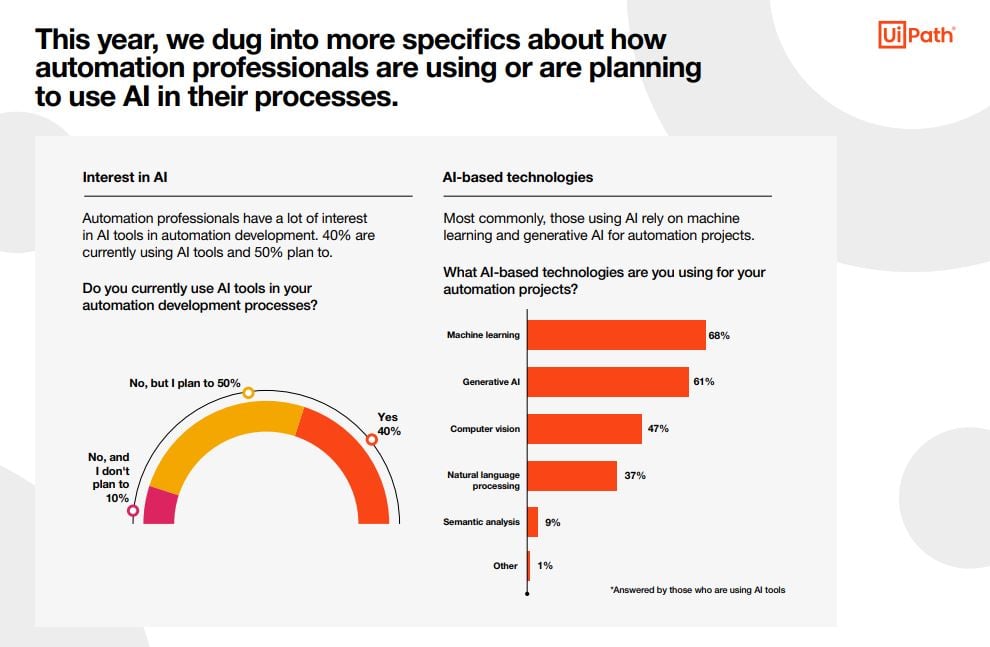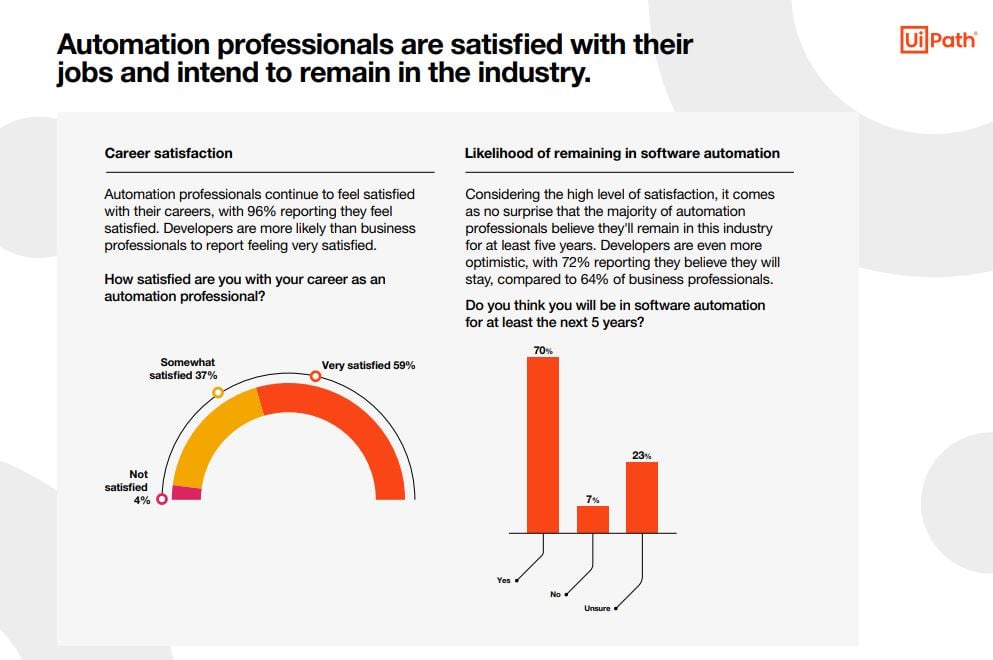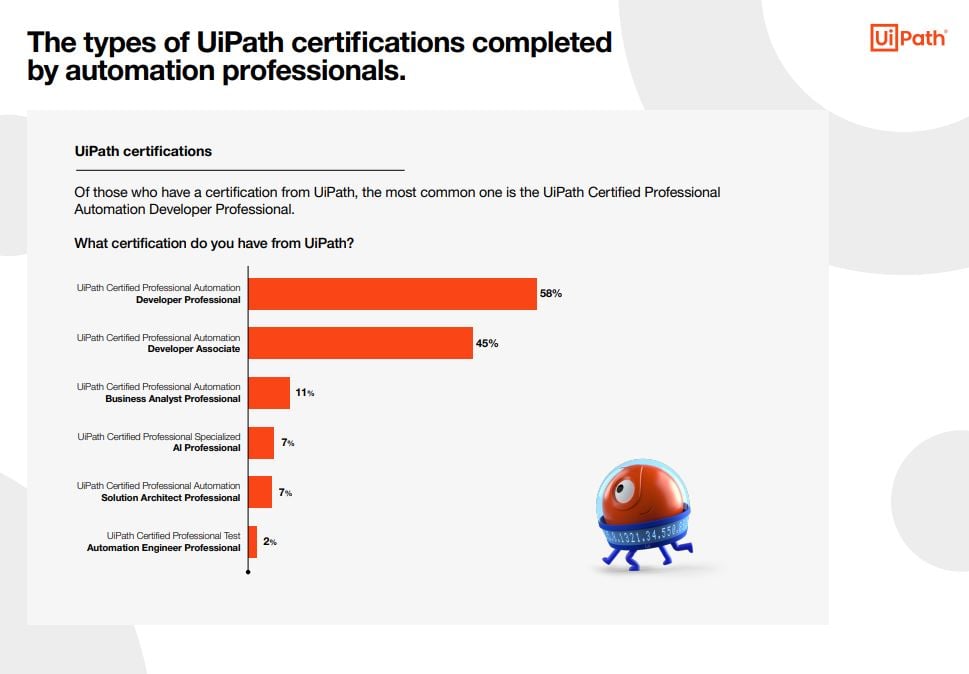State of the Automation Professional: 2024 key findings (Community blog)
State of the Automation Professional: 2024 key findings

With the latest State of the Automation Professional survey, we got to learn about the current reality, perception, and future of automation, and we want to share the results with all of you. Here are some insights we collected based on the 1,909 responses to the survey.
Smooth transition to AI automation
2023 was the year of discovery and preparation. 2024 is the year of integration and usage. Of course, we talk about all the functionalities and developments that came with generative AI, large learning models (LLMs) and the new agentic approach to process orchestration.
Last year, we learned from the previous report that professionals were planning to learn in depth UiPath Studio, AI Center, and Document Understanding™. Which they did. With that kind of preparation, now they can benefit more from the usage of specialized AI and GenAI integrations in their automation projects and get to have a smooth learning curve in adopting all the recent functionalities.
The latest developments in tech confirm the intention of automation professionals to integrate more AI products and functionalities, and the transition looks smooth for most of them given the early adoption and preparation they started some time ago. You can check the State of the Automation Professional report for some data points that support this statement.
40% of the respondents already adopted AI functionalities in their automation projects and 50% more plan to do the same. Out of those, more than 50% use AI tools and functionalities more than a few times per week.
Most professionals who use AI functions use them every day. ChatGPT and UiPath are the most-used technologies.

Satisfaction with the automation job
Automation professionals continue to be satisfied, have high trust in their role, and believe in their impact in the market and career. While some metrics show the trend has decreased or flattened, we still see automation developers as important contributors to the digital transformation of their organizations, influencing the use of new technologies, or having full trust from their leaders in doing their jobs. 86% of professionals think their current job in automation will help them with any future career moves they might make.
The trust in the future of automation is at one of the highest values, with more than 84% believing in the growth of the software automation space. With the same high increase, we see professionals feeling appreciated for the work they do in automation. 83% of automation professionals feel valued for the work they do, an increase from 75% last year.

Mature and growing AI automation teams
At a macro level, most professionals who responded see that their automation teams are growing in size and maturity, in specific jobs they must cover or across departments where they create automations.
Half of the automation teams in companies have about 25 employees who work on automation projects. Most of these people are developers, but there are also other jobs like business analysts, infrastructure engineers, technology managers, or test engineers that are growing in number. There are also significant large organizations where the automation teams get more than 250 or even 1,500 dedicated professionals to automate processes, which shows how fundamental the automation roles become to large organizations.
The industries that get to automate are the same as in previous years: finance, banking, insurance, healthcare, and manufacturing as leading industries. The departments that get the most from automations are the same leaders as in the past. These departments include accounting and finance, IT, and operations. Something new that we signaled this year on growth is the contact center and customer departments starting to automate more. You can also check out the dedicated e-book that showcases the use of automation for contact centers.
Best time to get certified
The market presents a big opportunity for learning and getting professionals certified in the automation space. There is massive intention for getting certified in the coming months, and there are good reasons to do so given the different automation certifications that exist and all the learning resources and community programs to support learners in being successful in their attempt. Find out more on how to get certified.
We see a bit more than 50% of the surveyed professionals already own a certification in automation, but the promise from them and all the others is to get further certified. 82% of respondents mentioned that they want to succeed in getting the UiPath Certified Professional Automation Developer credential in the coming 12 months, and we are pleased to see them continuing to learn and grow their expertise.
98% of all who contributed to the report learned actively in the last months, especially through video content in different formats—from self-paced courses, webinars, virtual events, structured courses on Academy, or video snippets on YouTube. Video format was the most-used learning method.

Primary focus for further learning is UiPath Autopilot™ and IDP products
There are specific UiPath products that received more attention in the last year and the consumption and expertise increased by more than 10%, as per the respondent's opinion. The future also shows that there is going to be accelerated growth in adoption and learning for a few others. There is no better time for professionals using the UiPath Platform given all the latest AI developments.
Among the products that show high growth in adoption and expertise, we see UiPath Integration Service getting an increase from 35% usage to 52% usage this year. Action Center grew with 10% to 56% adoption among professionals, and Automation Ops coming from 24% to 35% adoption.
As per future intention to grow expertise, we learn from the developers that they are eager to adopt more of UiPath Autopilot™ capabilities while the business automation professionals are ready to develop more into the core of automation and some extended AI capabilities: UiPath UiPath Document Understanding™, Communications Mining™, and Studio.
Conclusion
The State of the Automation Professional report 2024 is an annual report that gives insight into the evolution of the workforce in automation. The report addresses extensively the perception of job satisfaction of developers and professionals dedicated to automation projects, their intention to change careers, expertise, and learning opportunities ahead for them. The respondents are professionals representing different AI automation platform users, most of them being UiPath users that we get to meet in the UiPath Community, but not only.
Each year, we listen and learn from all the respondents, including students that plan to join the workforce, and we make sure we develop entire series of programs, community events, benefit, and opportunities to support all the automation professionals that choose to grow with the UiPath Community.
The report is also useful material that helps automation CoE leaders and people functions learn about their people and the overall situation of the workforce in automation. Make sure you get your own State of the Automation Professional report, and we grow the automation profession further.

Senior Director, Marketing Community, UiPath
Get articles from automation experts in your inbox
SubscribeGet articles from automation experts in your inbox
Sign up today and we'll email you the newest articles every week.
Thank you for subscribing!
Thank you for subscribing! Each week, we'll send the best automation blog posts straight to your inbox.



